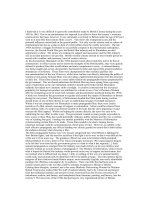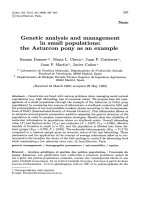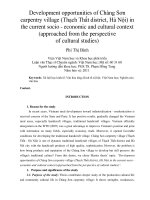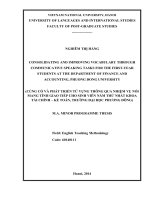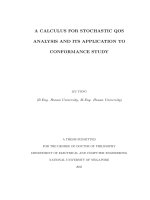Analysis and development of scanners for electrophoresis
Bạn đang xem bản rút gọn của tài liệu. Xem và tải ngay bản đầy đủ của tài liệu tại đây (1.02 MB, 74 trang )
ANALYSIS AND DEVELOPMENT OF SCANNERS FOR ELECTROPHORESIS
TAN HAN YEN
B.Eng.(Hons.), NUS
A THESIS SUBMITTED
FOR THE DEGREE OF MASTER OF ENGINEERING
DEPARTMENT OF MECHANICAL ENGINEERING
NATIONAL UNIVERSITY OF SINGAPORE
2006
Acknowledgements
First and foremost, I thank Lord Jesus Christ for giving me all the opportunity to
do my graduate study and for placing many special people in my life to share my
journey with me. It was also a journey of walking and growing in Him. I thank God
for granting me the talents to achieve this accomplishment and also most importantly
for my salvation.
I am also indebted to my supervisor, Dr. Ng Tuck Wah, for many years of
guidance and inspiration. I am truly grateful for your constant encouragement and
challenge for me to develop the best of my potential. You are a remarkable, talented
man who has gone beyond the call of duty in your roles of a lecturer, advisor, and
friend. I thank God for your warm heart and generous giving in supporting me
through out my journey of graduate study.
I am also extremely grateful to Dr. Liew Oi Wah from Singapore Polytechnic who
always greets me with kind smiles and have been tirelessly guiding me in my project.
I am very thankful to her lab assistant, Jenny and her students Weng Hua, Cynthia
and Carol for all their kind support in this project too. I thank all of you for your
thoughtfulness and continual support through out the development of the thesis. I will
never forget your kindness, and no words could suffice the depth of my gratitude.
I am also thankful for all the support and encouragements by my parents and my
two brothers and sisters through out my journey to complete this thesis.
Last, but not least, I want to give thanks to my wonderful girlfriend, Hwee Goon,
who has always been there for me since the time I started working on the thesis. Your
help and support made my journey to complete this thesis very pleasant, despite the
i
many stressful factors in the life of a student. I also thank you for your patience and
encouragement during some very busy times, and for providing me with crucial
insights.
ii
Table of Content
Acknowledgements
i
List of Tables
v
List of Figures
v
Summary
ix
1 Effects of illumination on densitometry of polyacrylamide gel
1
1.1 Introduction
1
1.2 Theoretical basis of illumination based on Gaussian model
2
1.3 Preparation of gel sample
4
1.4 Experimental procedures
5
1.5 Results and discussions
7
1.6 Conclusion
14
2 Spatial resolution in laser densitometry
16
2.1 Introduction
16
2.2 Measurement of Gaussian laser beam diameter
19
2.2.1 Experimental procedures
19
2.2.2 Results and discussions
21
2.2.3 Conclusion
22
2.3 Measurement of smaller Gaussian laser beam diameter
24
2.3.1 Experimental procedures
26
2.3.2 Results and discussions
28
2.3.3 Conclusion
30
iii
2.4 Investigation on effects of laser beam size in densitometry
31
2.4.1 Preparation of gel sample
32
2.4.2 Experimental procedures
33
2.4.3 Results and discussions
35
2.4.4 Conclusion
37
3 Investigation of transmission and reflective mode flatbed scanning
densitometry
39
3.1 Introduction
39
3.2 Basis of comparison between reflective and transmission mode
scanning
40
3.3 Preparation of gel sample
41
3.4 Experimental procedures
42
3.5 Results and discussions
43
3.6 Conclusion
46
4 Calibration of flatbed scanner for densitometry
47
4.1 Introduction
47
4.2 Preparation of gel sample
48
4.3 Experimental procedures
48
4.4 Results and discussions
50
4.5 Conclusion
52
5 Performance comparison between flatbed scanner with commercial
densitometer
54
5.1 Introduction
54
5.2 Preparation of gel sample
54
5.3 Experimental procedures
55
5.4 Results and discussions
56
5.5 Conclusion
59
Bibliography
60
iv
List of Tables
Table 4-1 Pixel intensity and corresponding optical density of transmission step
wedge when the Coomasie blue stained polyacrylamide gel sample and
transmission step wedge were scanned together.
50
List of Figures
Figure 1-1 A schematic description of the operation of a densitometer
1
Figure 1-2 Spectral distribution of fluorescent light
4
Figure 1-3 Experimental setup used to determine spectral optical density
distribution of a stained electrophoresis gel.
5
Figure 1-4 Experimental spectrum recorded using the setup in Figure 1-3
without (A) and with (B) a Coomassie blue stained band with protein amount of
1000 nanograms. The spectral optical density distribution computed from
distributions A and B is given in C.
7
Figure 1-5 Experimental spectral optical distributions obtained from Coomassie
blue stained protein band of different protein masses (in nanograms).
8
Figure 1-6 Simulation projections of optical density against protein mass per
band plots expected with light adhering to Gaussian spectral profile with 3nm
spectral widths (FWHM) at various center wavelengths.
9
Figure 1-7 Optical density against protein concentration plots expected with
light adhering to Gaussian spectral profile with 632.8nm center wavelength at
various spectral widths (FWHM).
11
Figure 1-8 Optical density against protein concentration plots expected with
fluorescent light with no filter, and with wideband Gaussian filters (100nm
spectral width FWHM at 0.7 transmission at central wavelength) incorporated
at central wavelengths corresponding to blue (450nm), green (550nm), and red
(600nm).
12
Figure 1-9 Simulation projections of optical density against protein mass per
band plots expected with light adhering to Gaussian spectral profile with 3nm
spectral widths (FWHM) at 650nm center wavelength. Experimental plots using
a diode laser source with the same spectral characteristics is included to verify
the validity of the simulation.
14
Figure 2-1 Illustration on position of smallest spot size of a Gaussian laser beam
16
v
Figure 2-2 Schematic description of the Gaussian laser beam diameter
measurement method using a quadrant photodiode
19
Figure 2-3 Plots of VL and VR against translation of the quadrant photodiode in
the x-direction
21
Figure 2-4 Plots of VT and VB against translation of the quadrant photodiode in
the y-direction
22
Figure 2-5 A Gaussian elliptical laser beam that has the principal axis not
coincident with the x or y axis of the quadrant photodiode
23
Figure 2-6 The physical gap between sensors in the photodiode does not permit
accurate measurement of the beam diameter
25
Figure 2-7 In the modified approach, the original position of measurement is
exclusively within one sensor
26
Figure 2-8 Plot of the sensor voltage against translation of the quadrant
photodiode in the x direction
28
Figure 2-9 Plot of the sensor voltage against translation of the quadrant
photodiode in the y direction
28
Figure 2-10 A Gaussian elliptical laser beam that has the principal axis not
coincident with the x or y-axis of the quadrant photodiode. The alignment
method also requires monitoring the voltage of one sensor as the beam traverses
over one edge
30
Figure 2-11 Schematic description of densitometric analysis of stained
electrophoresis gel (a) without and (b) with microscope objective in the laser
path
31
Figure 2-12 Coomassie blue stained gel image, shown in (a) full and (b) close-up
portion, recorded using the BioRad GS-800 densitometer and analyzed using the
Photoshop CS.
32
Figure 2-13 Plots of the computed optical density against protein mass in stained
polyacrylamide gel recorded using the Bio-Rad GS-800 densitometer and
analyzed using the Photoshop CS by computing the average optical density of
circular regions with various diameters.
35
Figure 2-14 Plots of the computed optical density against protein mass in stained
polyacrylamide gel using the laser densitometry setup without and with 10X
microscope objective.
36
vi
Figure 3-1 Illustration on reflective mode scanning
40
Figure 3-2 Illustration on transmission mode scanning
41
Figure 3-3 Gel Images from a) reflective mode and b) transmission mode
scanning whereby the number refers to the respective wells.
43
Figure 3-4 Plot of protein band pixel intensity of different dilution factor for
protein with 250kDa molecular size.
44
Figure 3-5 Plot of protein band pixel intensity of different dilution factor for
protein with 150kD molecular size.
44
Figure 3-6 Plot of protein band pixel intensity of different dilution factor for
protein with 100kDa molecular size.
45
Figure 4-1 Coomasie blue stained protein gel and calibrated transmission optical
step wedge guide were scanned separately. a) Calibrated transmission optical
step wedge and b) Polyacrylamide gel. Both the dotted box refers to the area of
background sample.
49
Figure 4-2 Coomasie blue stained protein gel with calibrated transmission
optical step wedge scanned together and dotted box showing the area of
background sample
49
Figure 4-3 Plots (scatter) of optical density against the intensity obtained from
each step of the calibrated transmission optical step wedge; in the case of
scanning transmission step wedge and gel sample together with red-separated
fluorescent light. A best-fit polynomial curve is computed and the equation used
for transformation is also shown.
51
Figure 4-4 Plots of optical density with respective scanning method
52
Figure 5-1 Image of stained polyacrylamide electrophoresis gel and calibrated
transmission optical stepwedge recorded using a flatbed scanner. Quantitative
inference of the amount of protein present can be obtained by taking the average
optical density value from a cross-section such as A-A.
55
Figure 5-2 Plots of optical density of first polyacrylamide gel sample from A)
Bio-Rad GS-800 densitometer, and flatbed scanning using B) red LED light, C)
red-separated fluorescent light, D) green-separated fluorescent light, E) blueseparated fluorescent light, F) non-separated fluorescent light, against protein
amounts in each wells
vii
56
Figure 5-3 Plots of optical density of second polyacrylamide gel sample from A)
Bio-Rad GS-800 densitometer, and flatbed scanning using B) red LED light, C)
red-separated fluorescent light, D) green-separated fluorescent light, E) blueseparated fluorescent light, F) non-separated fluorescent light, against protein
amounts in each wells
viii
57
Summary
Coomassie blue stained polyacrylamide gels are common in laboratories
committed to proteomics study and deoxyribonucleic acid (DNA) analysis. Currently,
laser densitometers are used in quantitative analysis of polyacrylamide gels.
However, the cost of a laser densitometer is expensive. Therefore, this thesis explores
possibilities of adapting commercial flatbed scanners by implementing optical
designs and electronic control schemes to evaluate a cheaper alternative to laser in
polyacrylamide gels densitometry.
Study was done to understand the underlying mechanisms of light interaction to
Coomassie blue stained polyacrylamide gels. Since, there is a vast scope of
illumination light source for scanning, ranging from coherent light to incoherent light,
simulations were done based on Gaussian model of illumination of different light
source. The simulation results were also verified experimentally with a 650nm diode
laser.
In addition, knowledge on diameter of laser beam is also essential to comprehend
laser applications in densitometry. So far, relatively low-cost and robust quadrant
photodiode have been demonstrated to measure Gaussian laser beam diameters in
millimeter range. However, there is a limitation for smaller diameter beams as all
quadrant photodiodes have a typical physical gap of about 50 microns between the
sensors. Thus, a modified measurement approach using quadrant photodiode was
investigated to measure small Gaussian laser beam diameter.
Once laser beam diameter can be determined, two different collimated laser beam
setups, one with a 10X objective and another without, were used to interrogate the
ix
gel. The 10X objective was used to produce a smaller interrogating beam. The laser
beam diameter was measured and optical density analysis between both setups was
compared to Bio-Rad GS-800 densitometer. However, both setups were limited to
peak optical density recording. Although average optical density is preferred to peak
optical density, it would require a more complicated and costly system.
This led to the investigation of the potential of inexpensive EPSON Perfection
1650 flatbed scanner. Initially, scanning performance using transmission and
reflective mode was investigated. It was found that transmission mode was
significantly better after processing of the images with MATLAB and analysis with
Quantity One® 1-D Analysis Software as compared to reflective mode.
Consequently, Epson Perfection1650 flatbed scanner was then modified to
perform transmission mode scanning with different light sources. However, one
problem in working with flatbed scanner was the unknown response characteristics of
the detector. Nevertheless, this was overcome by scanning the gel together with an
inexpensive calibrated transmission step wedge.
With the accurate calibration, valid performance comparison of flatbed scanner
using red LED light and EPSON transparency unit could be benchmarked with BioRad GS-800 densitometer. From the analysis, evaluations on sensitivity and linearity
performance of using flatbed scanner with red LED light and EPSON transparency
unit were benchmarked with Bio-Rad GS-800 densitometer. The study showed that
flatbed scanner with red LED light was a sensible alternative to commercial
densitometers which are typically expensive.
(469 words)
x
1
Effects of illumination on densitometry of
polyacrylamide gel
1.1 Introduction
Polyacrylamide gel electrophoresis is commonly used to separate molecules based
on size, shape, or isoelectric point for analysis of molecular weight and protein
composition and nucleic acids according to Lilley et al. (2002), Chakravarti et al.
(2004) and Hames and B.D. (1998). Generally, Coomassie brilliant blue is used to
stain protein bands of polyacrylamide gels for quantitative analysis and visualization
after electrophoresis as previously mentioned in Verma, R. et al. (2002), Stedman et
al. (2004) and Sasse, J. and S.R. Gallagher (2005). Usually, a laser beam with narrow
spectral band-limited source with 632.8nm wavelength is used to interrogate stained
protein bands in laser densitometry.
Figure 1-1 A schematic description of the operation of a densitometer
The amount of light absorbance by Coomasie blue stained protein bands that
correspond to protein concentration is measured in optical density (OD) units. At the
1
moment, there are no known studies on the effect of different light sources on the
optical density readings of stained protein bands in polyacrylamide gels. Such study
would allow better understanding to evaluate alternative light sources such as LEDs,
quartz halogen lamps, and fluorescent lamps. It would also provide insights to explain
and verify previous reports that were made by Kendrick, et al. (1994) and Vincent,
S.G. et al. (1997) concerning the range of optical density measurements using flatbed
scanners in comparison with laser densitometers.
1.2 Theoretical basis of illumination based on Gaussian model
Generally, light source for illumination can be classified as either following
Gaussian spectral profile or not. The spectral nature of light sources is described in
many texts like those by Levenson, R.M. et al. (1987) and Csele, M. (2004). The
intensity at any wavelength λ for light that follow a Gaussian spectral profile can be
expressed as
(
⎛−2 λ −λ
I (λ ) = I λ exp⎜
⎜
ω2
⎝
()
)
2
⎞
⎟
⎟
⎠
(1.1)
where λ is the central wavelength, and ω the radius of the Gaussian distribution. The
illumination power is given by
P=
π
2
()
I λω
(1.2)
The spectral width of the illumination is often defined by its value at full-width half
maximum (FWHM), wherein
d = 2 ln(2)ω
(1.3)
2
Hence equation (1.1) can be rewritten to incorporate the available data of illumination
power and spectral width as
(
⎛ − 4 ln(2) λ − λ
2P ln(2)
I (λ ) =
exp⎜
⎜
d2
d π
⎝
) ⎞⎟
2
(1.4)
⎟
⎠
The degree of light absorbance by any material is quantified by the optical density
parameter as describe in Simmons, J.H. and K.S. Potter (2000) and it is also applied
in densitometers to evaluate stain intensity that correlates to the amount of protein
present in the gels. A spectrometer can be used to determine the optical density, OD
( λ ) at every constituent wavelength of stained protein bands of the gel. If this band is
illuminated by a light source that follows a Gaussian spectral profile (as in equation
(1.4)), the intensity distribution can be taken to be the incident distribution. The
transmitted intensity at any wavelength can hence be found using
I (λ ) =
I i (λ )
10OD (λ )
(1.5)
In a densitometer, the measured optical density OD should be based on the total
incident and transmitted intensity through the protein band or
⎛ I i (λ )dλ ⎞
∫
⎟
OD = log 10 ⎜
⎜ I (λ )dλ ⎟
⎝∫ t
⎠
(1.6)
Equations (1.5) and (1.6) are still applicable in the event that the incident intensity
distributions do not conform to Gaussian spectral profile.
3
Figure 1-2 Spectral distribution of fluorescent light
A common example is fluorescent light that has the spectral distribution shown in
Figure 1-2. Filters – in particular Gaussian wideband types – are often used to obtain
band limited spectral illumination from such sources. The secondary intensity
distribution, Γ(λ ) derived by placing such filters in front of the source with primary
intensity distribution I (λ ) is given by
(
⎛ − 4 ln (2 ) λ − λ
f
Γ(λ ) = I (λ )T0 exp⎜
2
⎜
df
⎝
)
2
⎞
⎟
⎟
⎠
(1.7)
where λ f is the central wavelength of the filter, d f the spectral width at FWHM of
the filter, and T0 the maximum transmission.
1.3 Preparation of gel sample
Protein molecular weight standards (Precision Plus ProteinTM Standards, All
Blue), equipment and all reagents used for electrophoresis were obtained from BioRad Laboratories (Hercules CA). Recombinant His6-tagged fusion protein (molecular
4
weight: 29.4 kDa) was purified by immobilized metal affinity chromatography to
greater than 95% purity and quantified by the BCA assay (Pierce, Rockford IL,
USA). Vertical electrophoresis was carried out using a Mini-Protean®
Electrophoresis Cell and known amounts of proteins (10ng – 5000ng) were resolved
in 16% discontinuous SDS-polyacrylamide slab gel prepared according to the method
of Laemmli, U.K. (1970). The gel was stained overnight using colloidal Coomassie
G-250 dye (Gelcode® Blue Stain Reagent, Pierce) and was subjected to a Water Wash
EnhancementTM Step where the stain was replaced with several changes of ultrapure
water until a clear background was achieved. The destained gels were then dried
between two sheets of cellophane using the GelAir drying system (Bio-Rad).
1.4
Experimental procedures
Figure 1-3 Experimental setup used to determine spectral optical density
distribution of a stained electrophoresis gel.
The stained gel was studied using the setup in Figure 1-3. A stabilized 150W
halogen broadband light source illuminates the gel through an optical fiber bundle.
The light transmitted through the gel was collected using a single fiber (NA of 0.48)
5
with small diameter (1mm) so as to collect light only from stained protein band
region. Fiber with diameter larger than stained protein band region will result in
erroneous measurements, as the light collected will include that transmitted from the
stained and unstained regions of the gel.
The light in the single fiber was then channeled into a spectrometer, wherein a
grating broke down the light into its constituent spectrum before falling onto a linear
photodetector. Signals from the linear photodetector were then sent to a computer to
produce the spectrum distribution. The spectrum distribution of the light source
without the stained gel was first recorded as reference and followed by the recording
of the spectrum distribution of the gel with different protein concentration stained
with Coomassie blue. Division with the reference will produce spectral optical
density distributions for different protein concentration. From these spectral optical
density distributions, expected optical densities with light sources with known
spectral distributions were simulated using Microsoft Excel.
Another experiment to verify the simulation results was done using the setup
described in Figure 1-1. The incident light was a micro-focus diode laser of 650nm
wavelength with rated output of 10mW and spectral width of 3nm FWHM. The
transmitted light was recorded using a silicon photodiode that had a flat response
between wavelengths 400nm to 1100nm. The reading from the silicon photodiode
without the gel was first recorded as the reference. After this the gel was positioned
such that the laser light interrogated a Coomassie blue stained protein band
corresponding to a known protein amount and the reading from the silicon photodiode
was recorded. This step was repeated with other Coomassie blue stained protein
6
bands with different protein amount. In each case, the optical density value could be
computed from the reference.
1.5
Results and discussions
Figure 1-4 Experimental spectrum recorded using the setup in Figure 1-3
without (A) and with (B) a Coomassie blue stained band with protein amount of
1000 nanograms. The spectral optical density distribution computed from
distributions A and B is given in C.
Example experimental spectrum distribution recordings without and with a
Coomassie blue stained band with protein mass of 1000 nanograms is given in Figure
1-4 (indicated under A and B respectively). Both these distributions allow the spectral
optical density distribution to be computed, as indicated by C.
7
Figure 1-5 Experimental spectral optical distributions obtained from Coomassie
blue stained protein band of different protein masses (in nanograms).
Figure 1-5 presents samples of spectral optical density distributions obtained from
the experiment to interrogate the spectral characteristics of band stained with
Coomassie blue with different amounts of proteins (in nanograms). As expected,
higher protein masses correspond to higher optical density values across the
spectrum. The peak of each distribution was consistently invariant at about
wavelength of 593nm. The profiles were all also approximately Gaussian. It is
noteworthy that at low amounts (e.g. 10 nanograms) of the protein, the profile and
peak are almost non-discernible. This is compatible with the binding characteristic of
colloidal Coomassie G-250 dye present in the Gelcode Reagent where the detection
sensitivity for most proteins is approximately 25 nanograms/band, although some
proteins may be detectable at 8 nanograms/band. It is also important to note that
increment in optical density beyond 3400 nanograms/band of protein is marginal.
This is compatible with the known characteristic where complete binding of
Coomassie G-250 dye to protein (saturation) is approached. Since it is impossible to
8
achieve infinite Coomassie amounts, the optical density will essentially begin to
asymptote to a maximum relative to its finite amount. Clearly, the protein amounts
needed to achieve this characteristic should be dependent on the type of protein that is
present. In this case, the 3400 nanograms/band threshold appears to correspond
reasonably with previous reports by Vincent, S.G. et al. (1997) on 4000
nanograms/band for bovine serum albumin (BSA), smooth muscle myosin heavy
chain, and actin.
In all computations to predict optical density range response using the distribution
as in Figure 1-5, the radiant power incident on the gel was kept constant at unity. In
addition, spectral response of the detector was assumed to be uniform in the visible
range. This may not be the situation in all cases. Nonetheless, detectors with uniform
spectral response in the visible range are not uncommon and filters can be placed at
the input of detectors to achieve this spectral response characteristic.
Figure 1-6 Simulation projections of optical density against protein mass per
band plots expected with light adhering to Gaussian spectral profile with 3nm
spectral widths (FWHM) at various center wavelengths.
9
From the simulation done, the expected optical density against protein mass per
band plots with light adhering to Gaussian spectral profiles with 3nm spectral width
(FWHM) and various center wavelengths are presented in Figure 1-6. The spectral
width of 3nm was chosen to coincide with that normally found in lasers. In addition,
the wavelengths were also chosen to correspond to the emission of popular versions
of lasers available (514nm: argon-ion, 612.4nm: orange He-Ne, 632.8nm: standard
He-Ne, 650nm laser diode).
It can be seen that the distributions are noticeably non-linear and noisy. This is to
be expected as the point spectral measurement procedure of the stained gels
conducted here did not have the benefit of various “clean-up” procedures typically
applied in the processing of spatial densitometry images. Nevertheless, this does not
prevent conclusions to be derived from the range of optical densities predicted in
relation to the protein mass present. Quite clearly, the highest optical density range
response can be expected from the orange He-Ne source. This is due to the closeness
of the central wavelength of this light to the optical density peak of the stained gel
(about 593nm) as mentioned earlier. Nevertheless, there is only marginal reduction in
the predicted optical density range response if standard He-Ne is used instead. The
standard He-Ne lasers are more common and cheaper, thus make them a more
practical choice if one needs to decide between the two. The expected optical range
response with an argon-ion source is markedly lower. Hence, one should avoid using
it in interrogating Coomassie blue stained gels; despite being an expensive type of
laser.
10
Figure 1-7 Optical density against protein concentration plots expected with
light adhering to Gaussian spectral profile with 632.8nm center wavelength at
various spectral widths (FWHM).
Figure 1-7 presents the optical density against protein mass per band plots
expected with light adhering to a Gaussian spectral profile having 632.8nm center
wavelength and at various spectral widths (FWHM). It is observable that higher
optical density ranges can be expected with the use of sources with narrower spectral
widths. Nevertheless, it should be noted that there is only marginal difference in
optical density range response between 3nm (typical of lasers) and 50nm (typical of
LEDs) spectral widths. This infers that red LEDs should be able to provide an optical
density range response that is comparable to lasers. On the other hand, the optical
density range expected at 200nm spectral width – indicative of halogen lamp sources
– is markedly lower. That the central wavelength of halogen light (615nm) is closer to
the Coomassie blue optical density peak (about 593nm) should only offer minor
improvements in the range response.
11
Figure 1-8 Optical density against protein concentration plots expected with
fluorescent light with no filter, and with wideband Gaussian filters (100nm
spectral width FWHM at 0.7 transmission at central wavelength) incorporated
at central wavelengths corresponding to blue (450nm), green (550nm), and red
(600nm).
Figure 1-8 presents optical density against protein mass per band plots expected
with fluorescent light with no filter, and with wideband Gaussian filters (100nm
spectral width FWHM at 0.7 transmission at central wavelength) incorporated at
central wavelengths corresponding to blue (450nm), green (550nm), and red (600nm).
Interestingly, the expected optical density range responses using fluorescent light
without filter are much lower than that with halogen light (see Figure 1-6). This can
be attributed to the peaks in spectral distribution (e.g. at 547nm and 612nm)
wavelengths with fluorescent light (see Figure 1-2) that spread radiant power away
from the wavelength wherein the optical density of Coomassie blue (see Figure 1-4)
peaks. It is also interesting to note that the placement of green wideband Gaussian
filters is expected to markedly increase the optical density range response over the
fluorescent source without filter. The response is increased even higher with the
placement of red wideband Gaussian filters. Placing a blue wideband Gaussian filter
12
over the fluorescent source, however, should cause the optical density response range
expected to be almost non-existent. It should be noted that protein-dye binding
mechanics under specific preparation conditions could result in peak absorbance
wavelength shifts between 590nm to 620nm (Compton, S.J. and C.G. Jones (1985),
Splittgerber, A.G. and J.L. Sohl (1989), Congdon, R.W. et al. (1993) and Chial, H.J.
and A.G. Splittgerber (1993)). Nevertheless, this possibility should not significantly
affect the findings presented here due to the small amount of variation (i.e. 30nm).
Apart from simulation, it is possible to introduce an exhaustive range of physical
light sources (lasers, LEDs, halogen lamps etc.) to determine the expected optical
density trends experimentally. However, such an approach would entail the
investment of a substantial amount of resources. The simulation scheme adopted in
our work for optical density prediction is essentially to circumvent this need. We
verify the validity of our simulation scheme by comparing with experimental results
using one physical light source.
13
Figure 1-9 Simulation projections of optical density against protein mass per
band plots expected with light adhering to Gaussian spectral profile with 3nm
spectral widths (FWHM) at 650nm center wavelength. Experimental plots using
a diode laser source with the same spectral characteristics is included to verify
the validity of the simulation.
Figure 1-9 presents the optical density against protein amount plots predicted by
simulation for light with 650nm center wavelength and 3nm spectral width (FWHM)
and that measured experimentally with a laser diode source having the same spectral
characteristics. Despite fluctuations, the values can be seen to correspond within a
reasonable range and consistent trend. This verifies the validity of the simulation
model.
1.6
Conclusion
From the simulations, Gaussian spectral profile light with central wavelength
close to the wavelength corresponding to peak optical density for Coomassie blue or
with narrower spectral bandwidth at FWHM is expected to produce improved optical
density range response. Red LED light appears to be a good Gaussian with spectral
14
